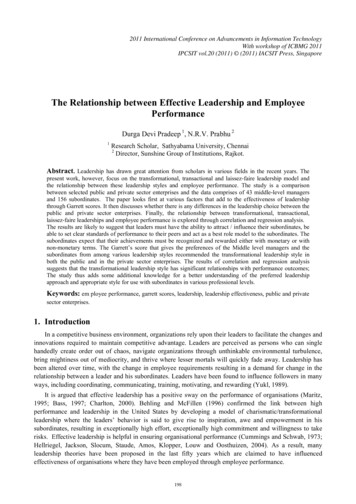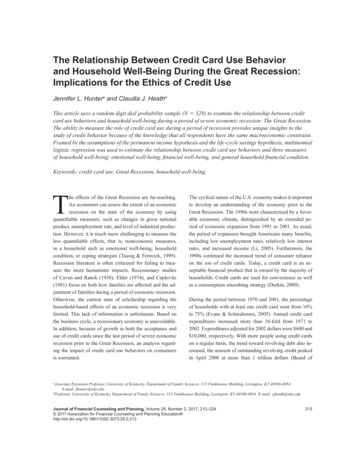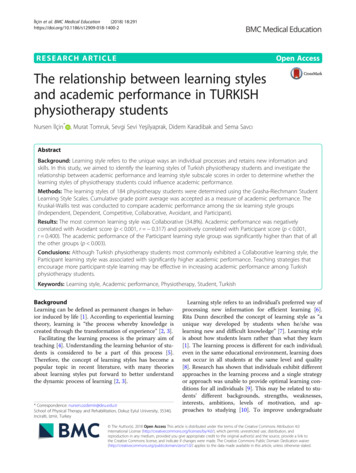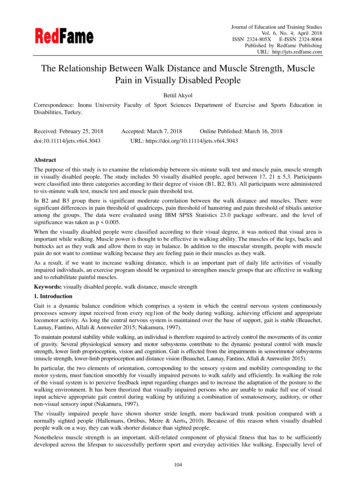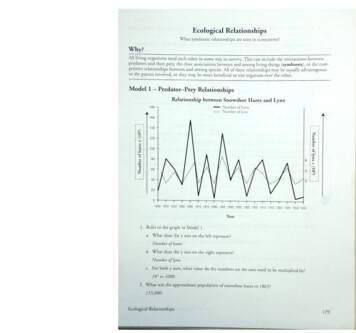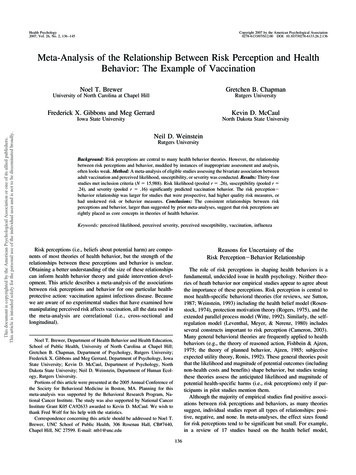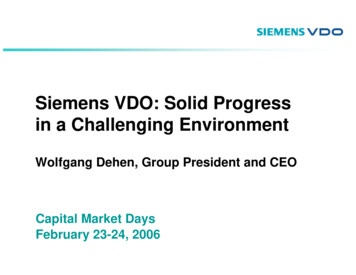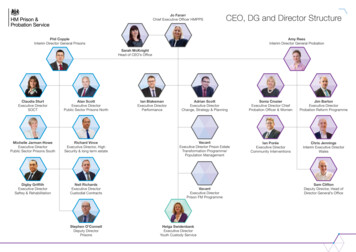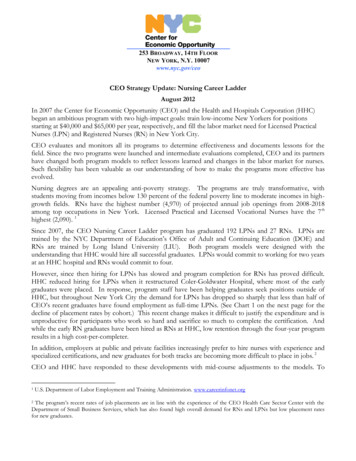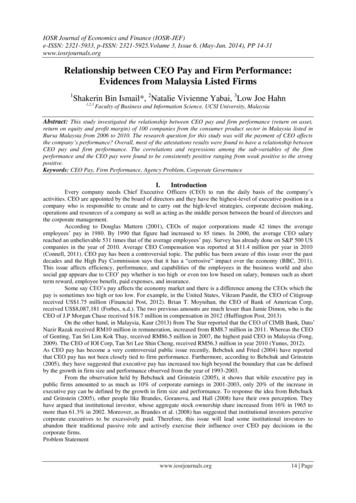
Transcription
IOSR Journal of Economics and Finance (IOSR-JEF)e-ISSN: 2321-5933, p-ISSN: 2321-5925.Volume 3, Issue 6. (May-Jun. 2014), PP 14-31www.iosrjournals.orgRelationship between CEO Pay and Firm Performance:Evidences from Malaysia Listed Firms1Shakerin Bin Ismail*, 2Natalie Vivienne Yabai, 3Low Joe Hahn1,2,3Faculty of Business and Information Science, UCSI University, MalaysiaAbstract: This study investigated the relationship between CEO pay and firm performance (return on asset,return on equity and profit margin) of 100 companies from the consumer product sector in Malaysia listed inBursa Malaysia from 2006 to 2010. The research question for this study was will the payment of CEO affectsthe company’s performance? Overall, most of the attestations results were found to have a relationship betweenCEO pay and firm performance. The correlations and regressions among the sub-variables of the firmperformance and the CEO pay were found to be consistently positive ranging from weak positive to the strongpositive.Keywords: CEO Pay, Firm Performance, Agency Problem, Corporate GovernanceI.IntroductionEvery company needs Chief Executive Officers (CEO) to run the daily basis of the company‟sactivities. CEO are appointed by the board of directors and they have the highest-level of executive position in acompany who is responsible to create and to carry out the high-level strategies, corporate decision making,operations and resources of a company as well as acting as the middle person between the board of directors andthe corporate management.According to Douglas Mattern (2001), CEOs of major corporations made 42 times the averageemployees‟ pay in 1980. By 1990 that figure had increased to 85 times. In 2000, the average CEO salaryreached an unbelievable 531 times that of the average employees‟ pay. Survey has already done on S&P 500 UScompanies in the year of 2010. Average CEO Compensation was reported at 11.4 million per year in 2010(Connell, 2011). CEO pay has been a controversial topic. The public has been aware of this issue over the pastdecades and the High Pay Commission says that it has a “corrosive” impact over the economy (BBC, 2011).This issue affects efficiency, performance, and capabilities of the employees in the business world and alsosocial gap appears due to CEO‟ pay whether is too high or even too low based on salary, bonuses such as shortterm reward, employee benefit, paid expenses, and insurance.Some say CEO‟s pay affects the economy market and there is a difference among the CEOs which thepay is sometimes too high or too low. For example, in the United States, Vikram Pandit, the CEO of Citigroupreceived US 1.75 million (Financial Post, 2012). Brian T. Moynihan, the CEO of Bank of American Corp,received US 8,087,181 (Forbes, n.d.). The two previous amounts are much lesser than Jamie Dimon, who is theCEO of J.P Morgan Chase received 18.7 million in compensation in 2012 (Huffington Post, 2013)On the other hand, in Malaysia, Kaur (2013) from The Star reported that the CEO of CIMB Bank, Dato‟Nazir Razak received RM10 million in remuneration, increased from RM8.7 million in 2011. Whereas the CEOof Genting, Tan Sri Lim Kok Thay, received RM86.5 million in 2007, the highest paid CEO in Malaysia (Fong,2009). The CEO of IOI Corp, Tan Sri Lee Shin Cheng, received RM56.3 million in year 2010 (Yunus, 2012).As CEO pay has become a very controversial public issue recently, Bebchuk and Fried (2004) have reportedthat CEO pay has not been closely tied to firm performance. Furthermore, according to Bebchuk and Grinstein(2005), they have suggested that executive pay has increased too high beyond the boundary that can be definedby the growth in firm size and performance observed from the year of 1993-2003.From the observation held by Bebchuck and Grinstein (2005), it shows that while executive pay inpublic firms amounted to as much as 10% of corporate earnings in 2001-2003, only 20% of the increase inexecutive pay can be defined by the growth in firm size and performance. To response the idea from Bebchuckand Grinstein (2005), other people like Brandes, Goranova, and Hall (2008) have their own perception. Theyhave argued that institutional investor, whose aggregate stock ownership share increased from 16% in 1965 tomore than 61.3% in 2002. Moreover, as Brandes et al. (2008) has suggested that institutional investors perceivecorporate executives to be excessively paid. Therefore, this issue will lead some institutional investors toabandon their traditional passive role and actively exercise their influence over CEO pay decisions in thecorporate firms.Problem Statementwww.iosrjournals.org14 Page
Relationship between CEO Pay and Firm Performance: Evidences from Malaysia Listed FirmsThe Importance of Corporate GovernanceIn 2002, the CEO pay report regulations were introduced in United Kingdom (UK) to furtherstrengthen the power of investors in relation to directors‟ pay. Further year on 2003, Australian securitiesExchange (ASX) reinforced the corporate governance principles and responded to community concerns with apolicy change that resulted in greater disclosure about CEO pay. The effectiveness of corporate governanceaffects the firm performance are totally undeniable. Having an efficient and effective monitoring skills inmanagement will tend to make the firm perform better. The conflict of interest between manager andshareholder exist all the time while corporate governance is the remedies for this issue by motivating themanager to work in the interest of shareholders.CEO Pay as a Popular Issue in Business RangeSome say CEO pay affects the economy market and there is a difference among the CEOs which thepay is sometimes too high or too low. The collapses of big corporation and financial institutions haveheightened the awareness of the issue arising from the way in which CEO are paid. Bebchuk and Grinstein(2005) have suggested that executive pay has increased too high beyond levels that can be defined by the growthin firm size and performance observed from the year of 1993-2003. According to Yatim (2012), more than adecade CEO pay has attracted an unfavorable attention from practitioners, academics and media that havefocused on the large amount of pay received by CEO. As a result of this issue, attention towards CEO pay hasbeen subject to a regulation and also pay disclosures.Impact of CEO pay towards Firm PerformanceThe impact of CEO pay towards firm performance brought a positive relationship. When theperformance of a firm increases then the CEO pay would increase too. Mainly because of CEO pay and firmprofitability are directly related to each other. Study that was done by Sigler (2011) mentioned that there is apositive and significant relationship between CEO pay and company performance measured by return on equity.However, in Malaysia there still less researcher performed a study based on this topic. Hence, in Malaysia theremay be a result that is totally different from other research. Based on the uncertainty, there is a motivation toconduct this study in order to find out the true effects of CEO pay and firm performance.Research QuestionsGenerally, the main questions that should be proposed is will the payment of CEO affect the company‟sperformance? In addition, from the general question that is proposed, it could be subdivided into few researchquestions.Below are the subdivide research questions:Question 1: What is the relationship between CEO pay and profit margin?Question 2: What is the relationship between CEO pay and ROE?Question 3: What is the relationship between CEO pay and ROA?Research ObjectiveThe main objective of this research is to examine the relationship between the CEO pay and firm performance inpublic listed companies in Bursa Malaysia. The research will determine how would the CEO pay affects thefirm performances of the companies. The research of this project will be based on 100 public listed companiesin Bursa Malaysia based on the annual reports from the year of 2006-2010 in consumer product sector.The main objectivity above can be sub-divided into each point:Objective 1: To examine the relationship between CEO pay and profit marginObjective 2: To examine the relationship between CEO pay and ROEObjective 3: To examine the relationship between CEO pay and ROASignificance of studyThis study is based on previous study that is conducted in the US. The result in US study shows that thesize of the firm appears to be a significant factor in determining the CEO pay (sigler, 2011). However, it mayappear to be different results due to the difference of economic environment and government policy. This studyexamines the relationship between CEO pay and firm performance of 100 consumer product firms that are listedin Bursa Malaysia for the financial year of 2006-2010.The significance of this study can be explained as follow. A study that was done previouslymajority in many-to-one relationship, where the CEO pay will be the dependent variable and board of director,CEO tenure, board independence, insider ownership and board size are the independent variables. In thisresearch paper, we will examine a one-to-one relationship between firm performance and CEO pay. This studyprovides the latest dataset that can be used in analyzing the corporate governance in consumer products firm thatwww.iosrjournals.org15 Page
Relationship between CEO Pay and Firm Performance: Evidences from Malaysia Listed Firmsis listed in Bursa Malaysia. In addition, the period for this study is from year 2006 to year 2010 which mayprovide an ideal setting on capturing the large economic cycle such as the sub-prime mortgage crisis thathappened between years 2007-2010. This will provide us a great opportunity in analyzing and testing theimpacts of different CEO pay on firm performance.Besides that, this study is conducted because there are still less researchers who have conducted a studyon a one-to-one relationship of CEO pay and firm performance in Malaysia. Our study actually based onprevious research that was done in US and China. One of the research papers in US shows that the size of thefirm appears to be a significant factor in determining the CEO pay (Sigler, 2011). One of the reports in Chinasays that “executive pay in public firms amounted to as much as 10% of corporate earnings in 2001-2003; only20% of the increase in executive pay could be explained by the growth in firm size and performance.” (Shin andSeo, 2010).It was found that mostly this study was done in western countries but lesser in Asia. Unlike othercountries like US and China, Malaysia provides an excellent advantage in conducting corporate governanceresearch because of the mixed-economic system that consist of market-based and control-based system.Furthermore, our study might be contributed to the marketeers especially in consumer products sectorcompanies since there are few numbers of researchers that had done their study on this area of business. Forthose undergraduate students that are interested in doing this study but in different sectors might be good anduseful as a references as well. Besides, shareholders of a particular company will also find this research usefulsince it helps to explain the reason behind the high pay of CEO.II.Literature ReviewThe development of this study is based on three related strands of literature review, namely, theliterature on the conflict of interest of principal and agent (theory of agency), literature on corporate governanceand the relationship of CEO pay and performance.Figure 1: Conceptual FrameworkDependent Variable: Firm performance- Return on Asset(ROA)- Return on Equity(ROE)- Profit Margin-Independent Variable: CEO PayModerator Variable: Agency ProblemCorporate GovernanceDependent and Independent VariablesCEO pay and firm performanceIn recent years, there is a widely held belief that top executives are overpaid (Gomez-Mejia, 1994) andCEO compensation has attracted the widespread of attention and has become one of the focus issue in corporategovernance (Felton, 2004). It shows that the increasing payment in CEO pay has numerous effects over twodecades in the business field. According to Bebchuk and Fried (2004), critics have voiced concerns about CEOpay has not been closely tied to the firm performance. Some studies stated that CEO pay is not always beneficial.Devers et al. (2007) has reported that the stock-based pay may encourage CEO to engage in negative behavioror so called fraud. Since there is a heavy usage of stock-based pay which provides CEOs with perverseincentives to maximize their private wealth, then CEO may have more advantage on boosting their accountingearning which is sometimes can be illegal. Other reason, CEO can control the firm and hence can force to agreeto the CEO‟s desired pay.www.iosrjournals.org16 Page
Relationship between CEO Pay and Firm Performance: Evidences from Malaysia Listed FirmsHaugen and Senbet (1981), Agrawal and Mandelker (1989), Lewellen, Loderer and Martin (1987] and Abowd(1990) has proposed that the type of behavior may be curbed is through linking the CEO pay to the firmperformance. Pay components such as bonuses, restricted stock and stock options may encourage managers tocarry out the wishes of company owners by tying payouts directly to firm performance. However, Sigler (2011)argued that the pay components like cash bonus, incentives plans, stock options and restricted stock awards mayalso attract some CEO to engage into activities that produces problems for the firm. Rewarding cash bonusesclearly shows an advantage for executives to do an undesired behavior. The cash bonus that is tied to theaccounting numbers may motivate CEO to manipulate the timing of revenues and expenses to maximize the payout for them. Sigler (2011) also mentioned that it may focused on the short term performance which may beharmful to the long term health of the firm.Some study says that aligning shareholder and mana
In 2000, the average CEO salary reached an unbelievable 531 times that of the average employees‟ pay. Survey has already done on S&P 500 US companies in the year of 2010. Average CEO Compensation was reported at 11.4 million per year in 2010 (Connell, 2011). CEO pay has been a controversial topic. The public has been aware of this issue over the past decades and the High Pay Commission says .


